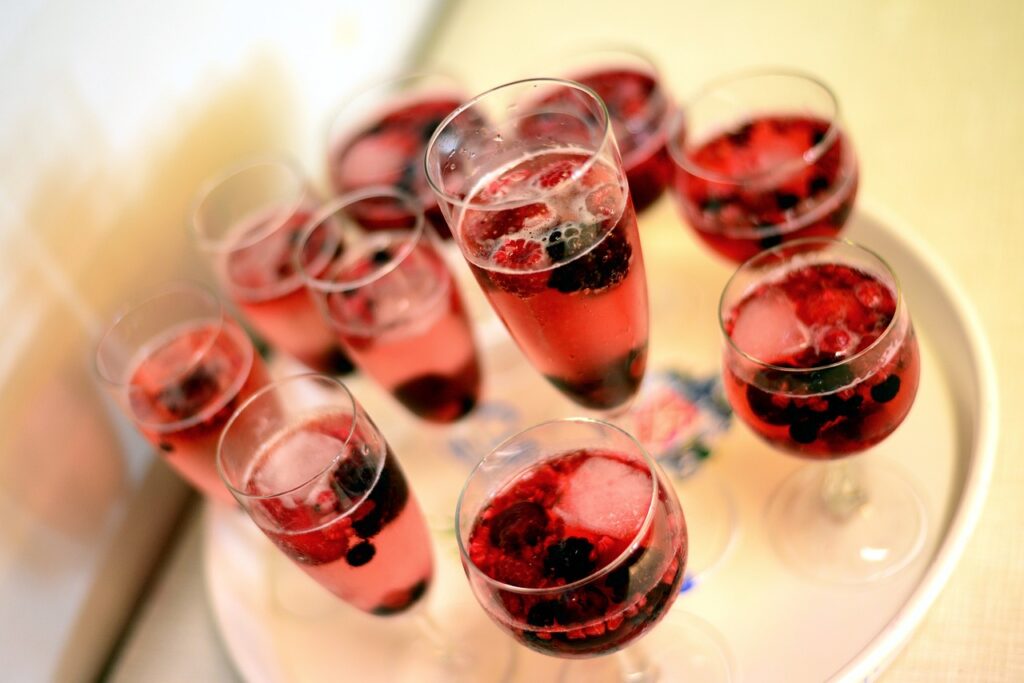Wine Mathematics: How Many Glasses in Your Bottle?

Understanding the importance of knowing how many glasses are in a bottle of wine involves several key aspects that contribute to a perfect wine experience.

Introduction
Planning and Preparation:
When hosting a gathering or event, having an accurate estimate of how many glasses can be poured from a single bottle of wine allows for better planning and preparation. This ensures that you have an adequate supply of alcohol for your guests, preventing any shortages or excesses.
Budgeting:
Knowing the number of glasses in a bottle helps in budgeting for wine purchases. Whether purchasing for personal consumption or for an event, it allows you to calculate the cost per serving and make an informed decision based on your budget constraints.
Portion Control:
Understanding the serving size per bottle promotes responsible consumption and portion control. This enables hosts and guests alike to enjoy wine in moderation, reducing the risk of overdrinking and ensuring a more enjoyable experience for everyone involved.
Read also – Cleanse Your Way to Wellness: The Ultimate Colon Broom Review”

Wine Pairing:
For those interested in wine pairing, knowing the number of glasses in a bottle can influence food and wine pairing decisions. This allows for better matching of the amount of wine with the number of courses or dishes served, improving the overall dining experience.
Hospitality and guest experience:
When hosting guests, providing them with the right amount of wine enhances their experience and has a positive impact on your hospitality. Being able to pour a reasonable number of glasses without running out or wasting wine contributes to a seamless and enjoyable social interaction.
Wine Appreciation:
Understanding the relationship between bottle size and serving size promotes a deeper appreciation of wine. It highlights the craftsmanship and attention to detail involved in winemaking, as well as the cultural and social importance of sharing wine with others.
In short, knowing how many glasses are in a bottle of wine is essential for effective planning, responsible consumption, and enhancing the overall wine experience for both hosts and guests. This enables better budgeting, portion control and wine pairing decisions while fostering hospitality and appreciation for the art of winemaking.

Standard Wine Bottle Size
A standard wine bottle is designed to hold a specific amount of liquid, which has been standardized over time for consistency in the wine industry. The volume of a standard wine bottle can vary slightly depending on the region and the type of wine being bottled, but it generally falls within a specific range.
The most common volume for a standard wine bottle is 750 milliliters (mL), which is equal to about 25.4 fluid ounces or about 1/5 gallon. This quantity has become the international standard for wine bottling and is widely used by wineries around the world.
The 750ml size is ideal for packaging and storing wine for several reasons:
Historical precedence:
The 750 ml size has a long history and tradition in wine making, dating back to the 18th century in Europe. Over time, it has become the preferred shape for wine bottles due to its practicality and convenience.
Read also – Can A Science Student Do Chartered Accountancy?

OPTIMUM QUANTITY:
750ml volume provides the optimal amount of wine for most occasions. This allows multiple servings to be poured from a single bottle, making it perfect for sharing among friends or enjoying during a meal.
Standardization:
Standardizing wine bottle sizes helps streamline production, distribution, and sales processes in the wine industry. This ensures uniformity in packaging and labeling, making it easier for consumers to understand and compare different wines.
Storage and Aging:
The 750 ml size is suitable for storing and aging wine, as it provides enough volume for the wine to develop and mature over time. The shape and size of the bottle also plays a role in preserving the flavor and character of the wine during storage.
While the 750 ml size is the most common, it is important to note that other standard bottle sizes are also used in the wine industry, including:
Magnum (1.5 litres): equal to two standard bottles
Jeroboam (3 litres): equivalent to four standard bottles
Methuselah (6 litres): equivalent to eight standard bottles
These larger bottles are often used for special occasions or for older premium wines, but are less commonly found in everyday consumption.

Overall, understanding the typical volume of a standard wine bottle, such as the 750 ml size, provides valuable insight into the packaging, serving, and enjoyment of wine. It reflects the traditions and standards of the wine industry while catering to the preferences and needs of wine consumers worldwide.
Standard Wine Bottle Size
A discussion of standard wine serving sizes involves exploring the various factors that affect how much wine is typically served in a glass. Here is a detailed description:
Cultural and regional variations:
Wine serving sizes can vary greatly depending on cultural norms and regional traditions. For example, in some European countries such as France and Italy, wine is often served in smaller quantities than in countries such as the United States, where larger drink sizes are more common. Understanding these cultural differences helps to understand what constitutes a standard serving size.
Type and style of wine:
The type and style of wine served also affects the standard serving size. Light wines such as white wine and rosé are often served in small quantities to preserve their delicate flavors and aromas. In contrast, fuller-bodied wines such as red wines can be served in larger quantities to fully appreciate their complexity and depth of flavor.
Glassware:
The size and shape of the wine glass used can affect the perceived serving size. Large glasses with wide bowls can give the impression of smaller pours, while small glasses with narrow openings can make the water appear larger. Additionally, the design of the glass can impact how the wine interacts with air, affecting its aroma and flavor.
Read also – Foods that are allowed and not allowed on flights

Social setting and occasion:
Social setting and occasion also play a role in determining standard wine serving sizes. For formal events such as wine tasting or fine dining experiences, smaller quantities are often preferred to allow guests to sample several wines without drinking too much. In more informal settings such as backyard barbecues or dinner parties, it may be acceptable to pour larger amounts of water, depending on the preferences of the host and guests.
Alcohol content and ABV:
A wine’s alcohol content, measured by its alcohol by volume (ABV), can affect how much is typically served in a standard drink. Wines with higher ABV levels may be served in smaller quantities to prevent overconsumption and intoxication, while wines with lower ABV may be poured more liberally.
Personal Preferences and Tasting Experience:
Ultimately, personal preferences and tasting experience also come into play when determining standard wine serving sizes. Some people may prefer to pour small amounts to slowly taste the wine and appreciate its nuances, while others may prefer to pour larger amounts for a more generous and delicious tasting experience.
By discussing these various factors, one can gain a comprehensive understanding of what a standard wine serving size is and how it may vary based on cultural, contextual, and personal considerations. This knowledge is essential for both hosts and consumers to ensure a responsible and enjoyable wine consumption experience.
Glass Size and Shape Influence
The discovery of the effect of glass size and shape on pour measurements reveals the complex relationship between the vessel and the poured liquid, especially in the context of wine. Here is a detailed description:
Glass shape and volume perception:
The shape of the glass can significantly affect the perception of poured volume. Pouring water into larger glasses may appear smaller, while pouring water into smaller glasses may increase the volume. This phenomenon is caused by the visual contrast between the liquid and the capacity of the glass, affecting how much wine one is receiving.
Glass shape and aroma concentration:
Glass shape plays an important role in concentrating the aroma of a wine, which can affect the tasting experience. Glasses with narrow openings, such as tulip or flute-shaped glasses, concentrate aromas more effectively, enhancing the wine’s bouquet. As a result, the small volume in these glasses can still impart strong aromas, making them suitable for aromatic wines like Riesling or Sauvignon Blanc.

Surface area and oxidation:
The surface area exposed to air in the glass affects the rate of oxidation, which affects the flavor profile of the wine. Glasses with wide bowls, such as Bordeaux or Burgundy glasses, expose more of the wine to air, speeding up oxidation and allowing the wine to breathe. As a result, the smaller stills in these glasses can still benefit from aeration, highlighting complex flavors and nuances.
By understanding the effect of glass size and shape on pour measurements, one can understand how these factors contribute to the overall wine tasting experience. Whether enhancing aroma concentration, facilitating oxidation, or improving visual presentation, the choice of glassware plays a vital role in maximizing wine enjoyment.
Conclusion
Final thoughts on mastering the mathematics of wine pouring cover the practical applications and broader implications of understanding the relationships between bottle shape, serving size, and glassware. Here is a detailed description:
Advanced Hosting and Entertaining:
By mastering the math of wine pouring, hosts can enhance their hosting and entertaining skills. Having a clear understanding of how many glasses can be poured from a bottle allows hosts to plan and prepare for social gatherings more effectively, ensuring guests do not run out of wine or waste on unnecessary bottles. Well served without spending much.
Responsible Consumption:
Knowledge of the mathematics of wine pouring promotes responsible consumption among both hosts and guests. Understanding standard serving sizes and portion control helps prevent overindulgence and encourage mindful drinking practices, thereby promoting a healthy and safe drinking environment.
Better Wine Pairing:
Mastering the mathematics of wine pouring enhances the art of wine pairing by enabling hosts and attendants to match the quantity of wine with the number of courses or dishes being served. By ensuring that each wine is served in optimal quantities, the tasting experience is enhanced, and the flavors of both wine and food are harmoniously balanced.
Cultural Appreciation:
Appreciating the mathematics of wine pouring also leads to a deeper understanding and appreciation of wine culture. Recognizing the historical significance of standard bottle shapes, the influence of regional traditions, and the importance of service rituals enriches the wine drinking experience, connecting enthusiasts to a rich tapestry of cultural heritage.
Read also –Why did it take humans so long to discover electricity and technology?

Personal enjoyment:
Ultimately, mastering the mathematics of wine pouring contributes to personal enjoyment and fulfillment. Whether hosting a dinner party, attending a wine tasting, or simply enjoying a glass of wine at home, the ability to pour with accuracy and confidence enhances the enjoyment derived from the experience, making wine tasting more enjoyable. Amateurs are allowed to savor every sip and moment.
Ultimately, mastering the mathematics of wine pouring is about more than just practical calculations – it’s about enriching the entire wine drinking experience. From hosting memorable celebrations to promoting responsible consumption and cultural appreciation, understanding the intricacies of the mathematics of pouring wine empowers enthusiasts to enhance their enjoyment and deepen their connection to the world of wine. Good luck mastering the art and science of pouring wine!






2 thoughts on “Wine Mathematics: How Many Glasses in Your Bottle?”